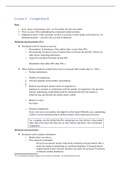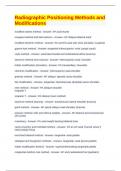Steps
1. In an ‘abuse of dominance case’, we first define the relevant market.
2. Then we asses if the undertaking has a dominant market position.
3. Important to know if this is present, to know if you have to look further at the behavior. No
dominant position = you don’t have to look at behavior!
Dominant market position (EU)
Threshold in the EU based on case law
o Presumption1 of dominance if the market share is more than 50%;
o Will generally be taken to exist if market share is between 40 and 50% if there are
other factors indicating dominance;
o Cannot be excluded if between 20 and 40%
(threshold is thus rather 40% than 50%..).
Other element considered include (these must be assessed when market share is <50%):
o Product substitution;
o Number of competitors;
This also depends on the market concentration.
o Market concentration (market share of competitors);
Important to consider in combination with the number of competitors. See previous
tutorial: undertaking could defend itself by stating that the relevant market is
relatively big, and therefor the market share is small.
o Barriers to entry;
See below.
o Potential competition;
Firm is not yet in your market, but might be in the future (Michelin case: undertaking
is able to switch manufacturing to another product while using same factories).
E.g.: company can also defend itself by stating that yes, they do have a big market
share. But at the same time there are no entry barriers and there’s lots of potential
competition.
Dominant market position
Economic tools to analyze dominance:
o Market share (see above)
o Price elasticity of demand
See previous tutorial: doesn’t help much in defining relevant market. But is
useful for stating if undertaking is considered dominant. If demand doesn’t
respond much to price increase, the price can easily be increased inelastic
is indicator market dominance.
1
It’s a presumption, meaning company is not yet defined as dominant – but the starting point is high.
, o Cross-price elasticity of demand
o Market concentration, three tools:
Concentration ratio
Looks at how concentrated market is beyond the single firm by
looking at combined market share of largest undertakings
Herfindahl-Hirschman index (HHi)
Gives a number of 0 to 100 of market share. Ex.: monopoly has a
market share of 100 100 x 100 = 10.000: sum of squares (value
between 0 and 10.000).
Used for merger control because of initial information about how
concentrated the market is.
Lerner index: difference between price and marginal cost
(P-MC)/P
Barriers to entry
Barrier to entry = how difficult would it be for other firms to enter your market?
Two types of barriers:
1) Legal: legally provided monopoly or difficult rules to first comply with before entering;
2) Practical barriers:
o Absolute cost advantages enjoyed by the incumbent and not borne by new entrants
Patents, copyrights, exclusive contract with suppliers
o First-mover advantages
Economies of scale, product differentiation, advertising, goodwill
o Vertical foreclosure and exclusion
Refusal to supply, tying, exclusive contracts
o Legal entry impediments
Licensing, certification, product registration requirements
Tricky: competition on the merits
On one hand we say: ‘you did a good job, firm, you earned it’ (e.g. patents). But on the other
hand we say: ‘patents are entry barriers’. Because the company was successful, it will be
considered dominant. Consequence is that the dominant undertaking cannot behave like a
regular firm – it must be more responsible according to competition law. It is not allowed to
distort competition. This can be seen as indirect punishment. Because you have been
successful in advertising, because it has economies of scale and because it has patents.. in the
literature there is a discussion on this.
NB: If the undertaking is considered to be dominant – this doesn’t have to be bad. It means the
undertaking has a special responsibility. Then we have to look at the behavior. If you are able to
escape the fact that you’re considered dominant – no one will look at your behavior.
End of step 2 (dominant market position) – take a closer look at the behavior
Assignment 12.1 Abuse
Abusive conduct (EU)
Exploitative abuse
Anti-competitive abuse, notably
o Exclusive dealing
o Tying and bundling
o Predatory pricing





